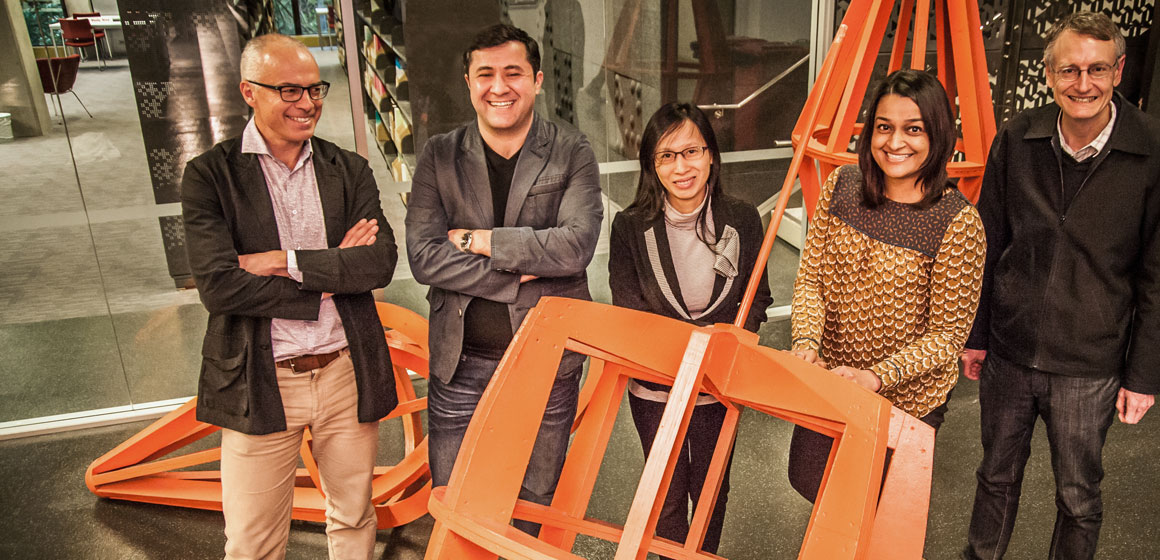
A key aim for University of Otago, Wellington's Burden of Disease Epidemiology, Equity and Cost-Effectiveness (BODE3) Programme is to build capacity and academic rigour in New Zealand in the estimation of disease burden, cost-effectiveness and equity impacts of health sector interventions.
It's an aim for which a team approach – using the strengths of its established and new researchers alike – is proving effective and paying dividends.
The dynamic between BODE3 programme leaders Professor Tony Blakely and Associate Professor Nick Wilson and three of the team's younger researchers – Dr Nisha Nair, Dr Giorgi Kvizhinadze and Dr Nhung Nghiem – is a case in point.
According to Blakely, Nair is taking BODE3 speedily down the “knowledge translation pathway”, whereby not only is information being disseminated more efficiently, but those who may be able to use the knowledge are being better equipped to do so.
A public-health medicine doctor who has worked in policy at both a DHB and ministry level, Nair is interested in the gap between research and policy. She also has first-hand experience of the pressures and timelines policy analysts face.
“Policy analysts need a lot of information quickly. They don't need it to be perfect, but they need it to be 90 per cent there and it needs to be done yesterday.”
She works closely with Kvizhinadze who has a background in statistics. Kvizhinadze's work to develop modelling capacity on the cost-effectiveness of health interventions is unique outside of that done by PHARMAC. He has also developed simpler versions of these models that can be accessed via online calculators – a response to feedback from policy analysts that, while the robustness of the full models is invaluable, at times they would settle for a more accessible, rapid assessment at the expense of some accuracy.
“For those working on a policy timeline, the precise cost-effectiveness of an intervention isn't always necessary – sometimes they just need to know whether it is crazy or reasonable and a calculator can tell them that,” Kvizhinadze explains.
There is a market for both formal evaluation and quick assessments, Nair adds, but an equally important part of the process is to get people in the health sector thinking about cost-effectiveness.
“It's not something that happens naturally,” she explains. “While there are people whose business includes cost-effectiveness – like PHARMAC or the National Health Committee – most of those who work in health have cost, rather than cost-effectiveness, in mind.”
Nghiem, meanwhile, has an economics background which has placed her well to develop BODE3's work in areas such as mathematical and econometric modelling, including cost-effectiveness.
A key and highly innovative area she is currently involved in is working out the health consequences – and future health-system costs consequences – of a change in price for certain food items. The econometrics of how much consumption changes as a result of a change in price is hugely complex, implicated by “cross price elasticity”, she explains.
“For example, if you change the price on sugary fizzy drinks, you need to look at not only what that does to its consumption, but what it does to the consumption of diet drinks, waters, energy drinks and so on.”
"As a research group, we're clearly going forward with building capacity and producing outputs that are valued by the New Zealand health sector."
Blakely emphasises the importance of pricing as a policy option worldwide for beating the obesity epidemic. But price elasticities and other complexities mean the quality of data on which to make policy decisions is “woefully inadequate”.
In an initiative to establish quality data, BODE3 is collaborating with Auckland University to create a virtual supermarket – part of a dietary programme being led by Auckland University on which Blakely is a co-director. The experiment will see around 1,500 people recruited and exposed randomly to prices (via five virtual shops each) so the team can work out how much subsidy or tax to put on items.
The excitement for BODE3 is that econometricians don't usually set up their own experiments to get such data.
“To date, that's been because you can't actually control the price out there in the real world. But with this move to a virtual world we've got complete control over the prices and can do our analysis on exactly the food groups that matter,” Blakely says.
Nghiem is collaborating closely with colleagues at the University of Otago in Dunedin and Auckland University to develop the best way to do this analysis – taking Blakely's lead and running with it.
Blakely: “BODE3 has an enviable mix of talented people with strengths based on a broad range of experiences. We agree on directions and then the team trusts them to fly with it and, as a research group, we're clearly going forward with building capacity and producing outputs that are valued by the New Zealand health sector.
FUNDING
- Health Research Council
- Ministry of Business, Innovation and Employment
